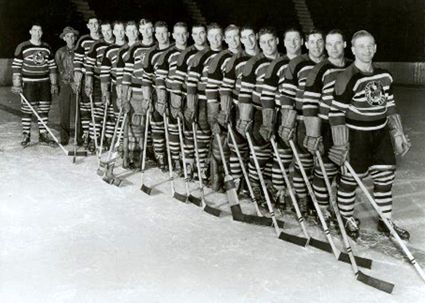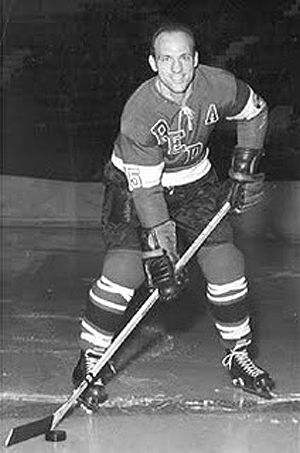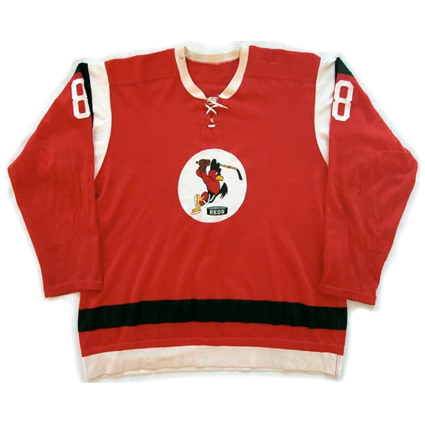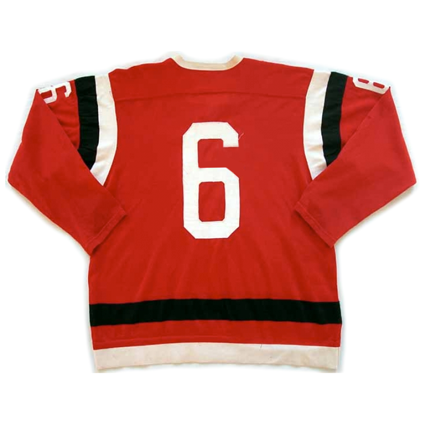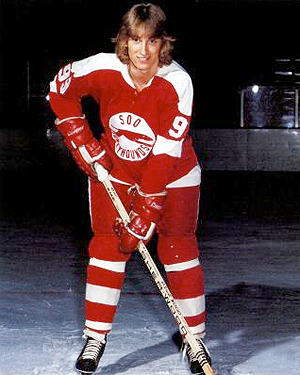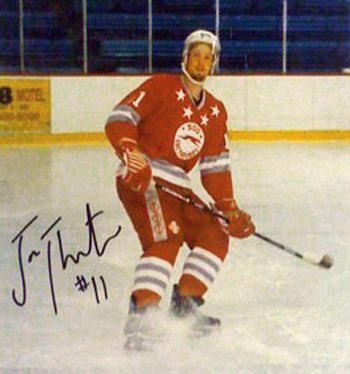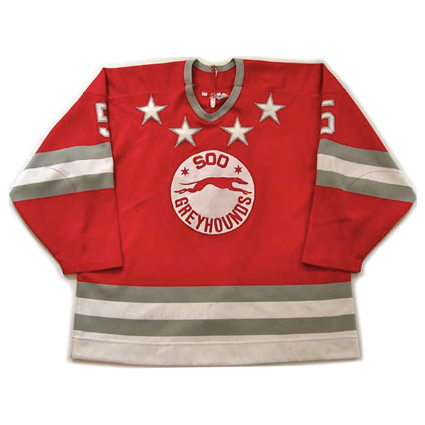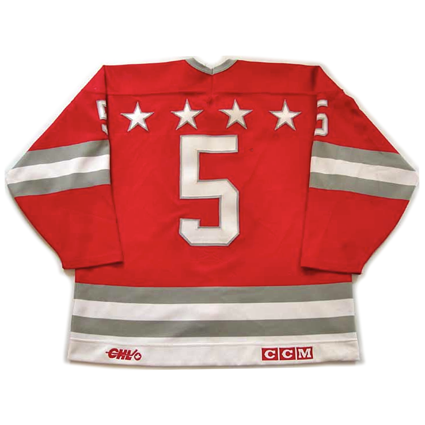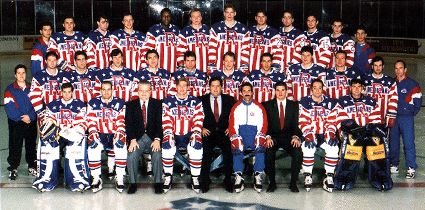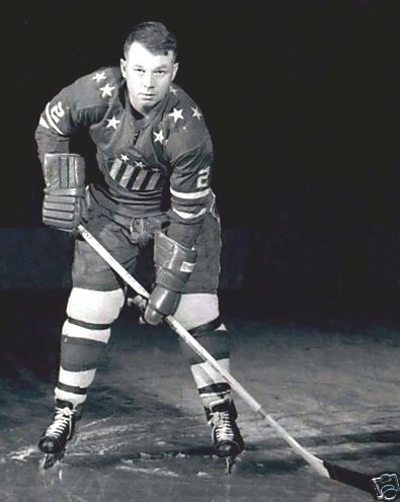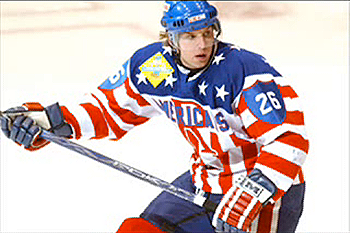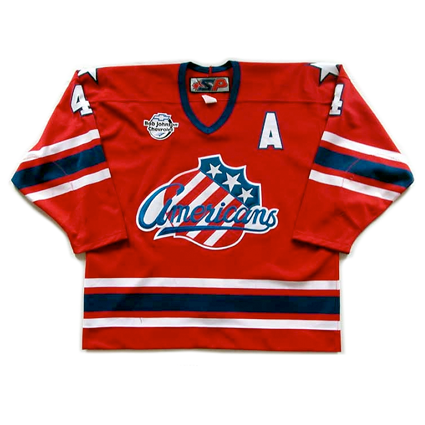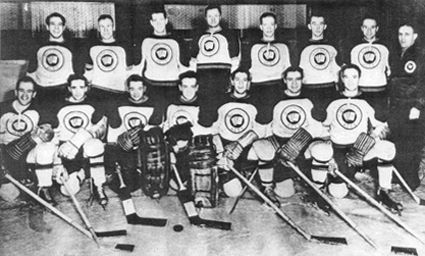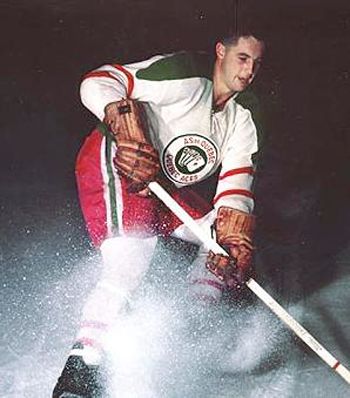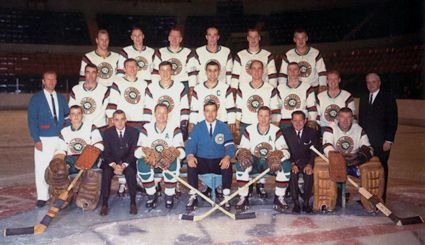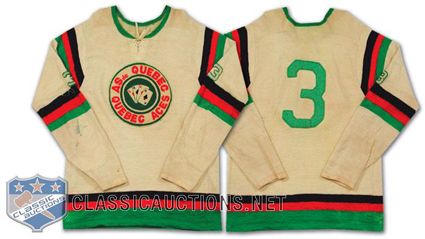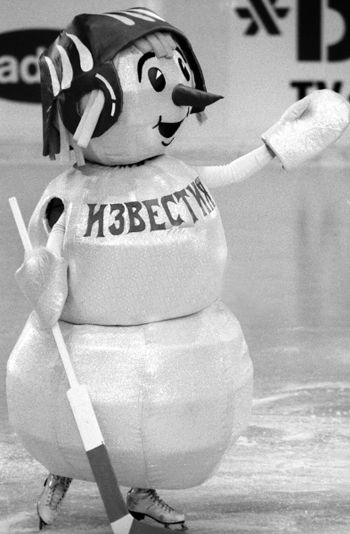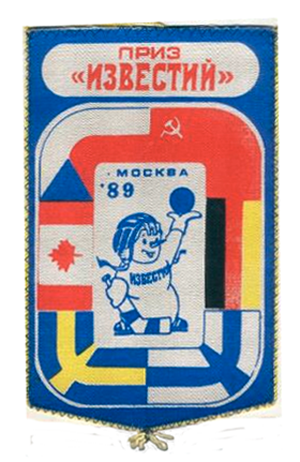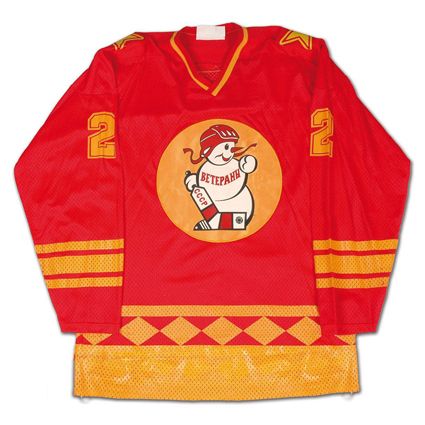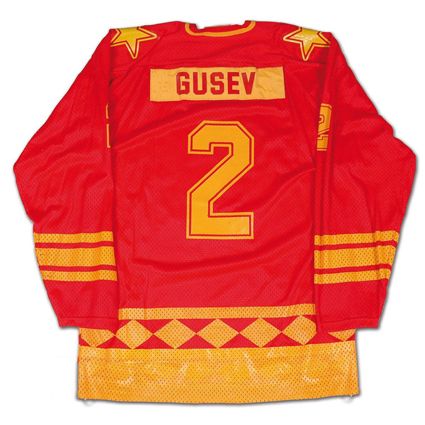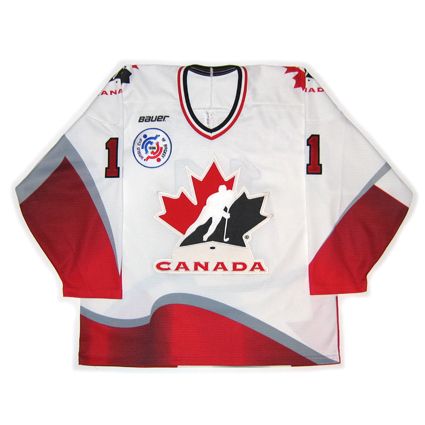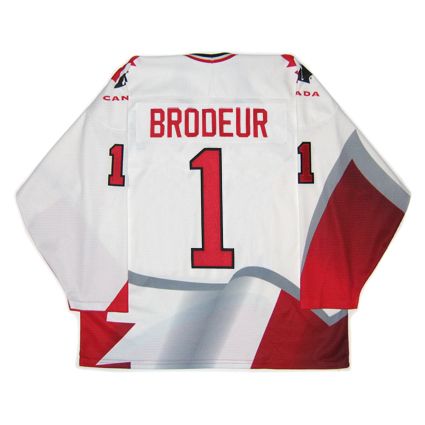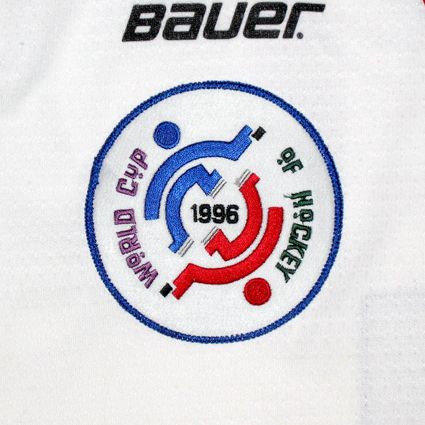Saturday, July 6, 2013
1970-71 Providence Reds Garry MacMillan Jersey
July by the Numbers returns once again to Rhode Island for jersey #6.
The Providence Reds were formed in 1926 and were member of the Canadian-American Hockey League. The Can-Am League lasted ten seasons with the Reds winning championships in 1930, 1932 and 1934.
The 1929-30 Providence Reds, the Reds first championship season
When the league shrank to just four teams, it merged with the International Hockey League to form the International-American Hockey League in 1936 and shortened it's name to the American Hockey League in 1940.
The Reds won it's first Calder Cup as champions of the AHL in 1938 and repeated the feat two seasons later in 1940. A third title arrived in 1949 following a stellar 44-18-6 regular season before the Reds won their fourth and final championship in 1956 in a terrific turn of fortune, coming after three losing seasons during which they failed to even qualify for the playoffs.
The 1948-49 Calder Cup champion Providence Reds
After winning four Calder Cups in the space of 19 seasons, the Reds next 11 seasons saw them either eliminated in the first round of the playoffs six time or completely out of the postseason five times.
Despite a losing record in 1970-71, when they posted a 28-31-13 record, the Reds made their first return to the finals since 1956. The Reds Best season since their 1956 title winning season came in 1973-74 when they went 38-26-12 and made another trip to the finals. They not only improved on their record again the very next season, but established a club record with 98 points following a 43-21-12 march through their schedule, only to go down to defeat in Round 1 of the playoffs in six games to the Springfield Indians.
The 1970-71 Providence Reds
Following the 1977-78 season, the franchise would relocate to Binghamton, New York, where it would play under a series of names for 20 years until relocating once again to Hartford, Connecticut where it was known as the Hartford Wolf Pack for 13 seasons before a change in ownership resulted in yet another name change, this time to it's current name, the Connecticut Whale. It would not be until 1992 that hockey would return to Providence in the form of the Providence Bruins.
Zellio Toppazzini
Notable players over the long history of the Reds include Johnny Bower, Ed Giacomin, Ed Johnstone, Rick Middleton, Bill Mosienko, Ron Stackhouse and franchise all-time leading scorer Zellio Toppazzini who played for the Reds from 1951 to 1964.
Today's featured jersey is a 1970-71 Providence Reds Garry MacMillan jersey which features vertical striping where the arms meet the body, which is a style more closely associated with football jerseys.
The crest of the jersey is a cartoon of a rooster (since a "Rhode Island Red" is a breed of chicken) in full windup for a slapshot.
Today's video highlight is Tooazzini receiving an award from the owner of the Reds back in the early 1960's, followed by some action highlights.
Labels:
AHL,
Providence Reds
Friday, July 5, 2013
1990-91 Sault Ste. Marie Greyhounds Adam Foote Jersey
July by the Numbers crosses back into Canada for jersey #5.
The Sault Ste. Marie Greyhounds of the Ontario Hockey League are a junior team which began play in 1962 in the Northern Ontario Hockey Association (NOJHA), but the name Greyhounds has been used by teams in "The Soo" as far back as 1919, as is often the case with traditional team names in Canadian Juniors.
The 1924 Sault Ste. Marie Greyhounds
The name Greyhounds was originally suggested back in 1919 as a jab at the rival Sudbury Wolves, with the thinking that a greyhound is much faster than a wolf.
The current team was formed in 1962 as a Junior A team and did not have a losing season while in the NOJHA, which included winning the championship in 1967, 1970 and 1972. While the league was originally six clubs, two eventually folded, which caused the league itself to disband, sending the Sault Ste. Marie and Sudbury to seek entrance into the Ontario Hockey League for the 1972-73 season.
Their first season in the OHA was a rough one, going just 11-42-10. They managed, barely, their first winning season in 1975-76 with a 27-26-13 mark. It was in 1977 that the Greyhounds put themselves on the map when they drafted a 16 year old, 5' 8", 155 pound Wayne Gretzky in the Ontario Midget Draft.
Gretzky originally requested to wear sweater #9, but Brian Gualazzi was already wearing it. After wearing #19 for a few games, Greyhounds coach Muzz MacPherson suggested two nines would be better than one, and thus Gretzky's iconic #99 came into being.
Gretzky only played for the Greyhounds for one season before turing pro as an underage player with the Indianapolis Racers of the WHA, but while with the Soo, he led the club in scoring with 70 goals and 112 assists for 182 points in just 64 games, a 2.84 points per game average! Amazingly, he did not lead the league in goals, assists or points, finishing second in goals to Dino Ciccarelli's 72 and second in assists and points to Bobby Smith's 123 and 192, respectively.
The Greyhounds would win the league, by now renamed the Ontario Hockey League, playoff title in 1985 following a stellar 54-11-1 regular season record to advance to the Memorial Cup tournament for the first time. They returned to the Memorial Cup by winning the OHL playoffs again in 1991, 1992, this time making it to the championship final, and again in 1993, this time as the host team, while becoming one of only three teams to make three consecutive Memorial Cup appearances.
The finished the round robin portion of the competition with a 2-1 record to advance to the finals, where they delighted the home fans by capturing their first national championship with a 4-2 win over the Peterborough Petes.
The 1993 Memorial Cup champion Sault Ste. Marie Greyhounds
In 1997, the first Greyhound ever was selected first overall in the NHL Entry Draft when the Boston Bruins chose Joe Thornton with the first pick.
Joe Thornton
To date, the Greyhounds have won nine division titles, three league championships and one Memorial Cup. Additionally, they have retired four numbers, #1 for goaltender JohnVanbiesbrouck, #4 for defenseman Craig Hartsburg (both of whom later returned to coach the Greyhounds), #10 for Ron Francis and #99 for Wayne Gretzky.
Since 1962 a long and impressive list of notable players to have played for the Greyhounds, including Tony Esposito, Ivan Boldirev, Jerry Korab, Jeff Bukeboom, Jeff Carter, Paul Coffey, Adam Foote, Derek King, Bob Probert, Charlie Simmer, Steve Sullivanand Rick Tocchet in addition to those who have had their numbers retired.
Today's featured jersey is a 1990-91 Sault Ste. Marie Greyhounds Adam Foote jersey. The Greyhounds have used their classic profile of a running greyhound for every one of their years of existence but four, when a new cartoonish logo was introduced for a brief period before fan backlash sent the club back to their original logo.
Today's video segment begins with the 1993 playoff game between the Greyhounds and Petes which determined that Sault Ste. Marie would host the 1993 Memorial Cup, which they would go on to win in front of their home fans.
This next video is a reunion of that same 1993 club with interviews with several of the players.
Labels:
Sault Ste. Marie Greyhounds
Thursday, July 4, 2013
2002-03 Rochester Americans Rory Fitzpatrick Jersey
July by the Numbers reaches #4 with the most appropriate jersey possible on America's birthday.
The patriotically named Rochester Americans were founded in 1956, making them the second oldest franchise in the American Hockey League by far, with the third oldest still active team having been founded in 1992.
The Americans have made it to the Calder Cup Finals 16 times, having won the championship six times, first in a run of success that encompassed 1965, 1966 and 1968 as well as an appearance in the finals in 1967, the only team to reach the finals in four consecutive seasons. Other championship titles came in 1983, 1987 and most recently in 1996.
The Calder Cup champion 1995-96 Rochester Americans
Well known players from the early days of the Rochester franchise include goalie Gerry Cheevers, future Islanders coach Al Arbour, future Bruins coach and TV commentator Don Cherry, Jim Pappin and Mike Walton.
Rochester American Don Cherry
After a down period in the late 1960's under the ownership of the Vancouver Canucks, when the team finished last for four straight seasons, local owners purchased the club and installed the dynamic Cherry as coach and general manager which paid dividends as the Americans finished with the best regular season record in 1973-74.
The Americans were later purchased by the owners of the Buffalo Sabres, which naturally led to their becoming the Sabres AHL affiliate, a partnership which lasted from 1979 to 2008, the longest such partnership in AHL history at 29 years which included three championships. Following three seasons apart, circumstances changed which brought the two clubs back together again when new Sabres owner Terry Pegula purchased the Americans in time for the 2011-12 season.
Two numbers have been retired by the team in honor of three players, the #6 for Red Armstrong and #9 for both Dick Gamble and Jody Gage, who broke Gamble's team scoring records.
Jody Gage
Recognizable names to have played for the Americans include Maxim Afingenov, Donald Audette, Martin Biron, Brian Campell, Randy Cunneyworth, Benoit Houge, Ales Kotalik, Uwe Krupp, Mike Milbury, Ryan Miller, Jason Pominville, Darren Puppa, Thomas Vanek and even Grant Fuhr.
Thomas Vanek in the Americans flashy alternate stars and stripes sweater
Today's featured jersey is a 2002-03 Rochester Americans Rory Fitzpatrick jersey. With it's red, white and blue color scheme, patriotic sheild logo and #4, we couldn't think of a more appropriate jersey for the Fourth of July, as it even features sponsorship from a local Chevrolet dealer. All you need while wearing this one would be for your mom to serve you some apple pie!
With it's shield crest, classic Northwestern striping pattern and shoulders decorated with basic stars, this jersey's understated elegance creates a timeless look often left behind in this modern age of excessive piping and gimmicky fonts. A true classic jersey in every sense.
Today's video section begins with Gage scoring his 14th goal of the playoffs in Game 7 of the 1987 Calder Cup Finals, leading to the Americans to their fifth Calder Cup championship.
Here is a further look at Jody Gage, an AHL MVP and member of the AHL Hall of Fame.
Labels:
AHL,
Rochester Americans
Wednesday, July 3, 2013
1951-52 Quebec Aces Joe Crozier Jersey
Juillet par les Numéros de maillot n ° 3 vient de la province de Québec, Canada sous la forme de Les As de Québec.
The Québec Aces were founded as an amateur club back in 1928 as a member of the Quebec City Railway-Paper League, where they played until 1936. They joined the Quebec Amateur Hockey Association for the 1936-37 season, playing in the league for five seasons with a best finish of second in 1937-38.
Their next destination was the Quebec Senior Hockey League, beginning in 1941-42. They won the Allan Cup as champions of Canadian senior hockey in 1944.
The 1944 Allan Cup champion Québec Aces
Easily the most recognizable and famous of the Aces was future Montreal Canadiens captain Jean Béliveau, who played for the club for two seasons. He had refused to join the Canadiens, preferring to remain with Québec, in part due to the fact he was making double the average NHL salary at the time. Led by Béliveau, the Aces won the league title in 1952.
The most famous of all the Aces, Jean Béliveau
A series of behind the scenes dealings saw the league turn professional in 1953-54, which resulted in a name change to the Quebec Hockey League. The Aces continued to play in the QHL until it's demise in 1959, which prompted Québec to join the American Hockey League. while in the QSHL/QHL, the Aces had won regular season championships in 1944, 1945, 1952 and 1957, and playoff championships in 1942, 1954 and finally 1957, going on to defeat the champions of the Western Hockey League, the Brandon Regals, for the Edinburgh Trophy.
The Aces in 1948-49, surrounding their gorgeous center ice logo
The Aces found the going tough in their early days in the AHL, failing to make the playoffs during their first four seasons before reeling off three consecutive division championships in 1964, 1965 and 1966. They made the Calder Cup Finals in 1964, but lost to the Cleveland Barons.
The Calder Cup finalist 1963-64 Aces
The club became the minor league affiliate of the expansion Philadelphia Flyers in 1967-68, which saw them immediately return to the Calder Cup Finals in 1968 and 1969, unfortunately coming up short both times.
The Aces new winged logo, reflecting their affiliation with Philadelphia
The team would play two more seasons prior to the Flyers moving the franchise to Richmond, Virginia where they were renamed the Richmond Robins, brining an end to the Aces after 44 seasons.
Today's featured jersey is a 1951-52 Québec Aces Joe Crozier jersey worn during the period of time that Béliveau played for the club, guiding them to the 1952 league championship.
This classic wool sweater features a beautifully excited chenille crest with the #3 on the back in felt.
Crozier was a defenseman who played 8 seasons with the Aces as part of his 12 year career, which included reaching the NHL with the Toronto Maple Leafs for 5 games in 1959-60. He would then go into coaching, winning three Calder Cups with the Rochester Americans of the AHL in 1965, 1966 and 1968. He would eventually coach the Buffalo Sabres and Maple Leafs in the NHL as well as the Vancouver Blazers and Calgary Cowboys of the WHA in addition to the minor league and junior clubs he would command from 1961 to 1984.
Today's video segment is a look at the career of Jean Béliveau from the Legends of Hockey series.
Labels:
Beliveau Jean,
Quebec Aces
Tuesday, July 2, 2013
1989 Soviet Union Izvestia Trophy Alexander Gusev Jersey
July by the Numbers continues with jersey #2, a 1989 Soviet Union jersey worn during the annual Izvestia Trophy tournament, which was originally sponsored by the Izvestia daily newspaper.
The Izvestia Snowman, the traditional tournament mascot
The tournament began in 1967 in Moscow and has traditionally been played in December each year with few exceptions between the top national teams of Europe. In the 1970's and 80's it was referred to as "The Little World Championship" or a winter rehearsal for the World Championships held each spring.
The first tournament held in 1967 carried the heavy-handed title of "Tournament for the Celebration of the 50th Anniversary of the Great October Socialist Revolution", which probably hampered merchandise sales to no end!
The pendulum swung back way too far in the other direction for 1968 when the competition was entitled the overly generic "International Tournament". The Izvestia sponsorship arrived on the scene in 1969 and lasted through 1996, giving the tournament both increased exposure and it's identity.
Since the end of the Izvestia sponsorship, the tournament has been through a series of name changes, first being known as the Baltica Brewery Cup from 1997 to 2002, the Moscow International Tournament in 2003, the Rosno Cup in 2004 and 2005 and is currently known as the Channel One Cup since 2006.
The tournament has consisted mainly of national teams from Finland, Czechoslovakia/Czech Republic, the Soviet Union/Russia and Sweden with other countires fielding a teams on occasion.
Over it's history, the Soviet Union/Russia has won the tournament 31 times, Czechoslovakia/Czech Republic seven, Sweden and Finland two each and Canada once.
The Soviet team captain hoists the Snowman trophy
Other countries to have participated include Poland in 1967, East Germany in 1969, the Winnipeg Jets in 1976, and the Quebec Nordiques in 1977, both of the WHA representing Canada, and West Germany on a few occasions prior to reunification. There were later Canadian teams on occasion as well as two teams from the Soviet Union and Czechoslovakia in the early days as well.
Currently, the tournament is a part of a larger competition known as the Euro Hockey Tour, which consists of the Channel One Cup in Russia, the Czech Hockey Games, the Karjala Tournament in Finland and the LG Hockey Games in Sweden. Once all four of these competitions are completed, the teams are seeded based on combined points for all four tournaments to determine the overall winner, with additional playoff games having been added from 2004 to 2007 to determine the medal placings.
Most teams currently use the tournament as an opportunity to give younger players a chance to gain international experience in advance of World Championships or Olympics.
Today's featured jersey is a 1989 Soviet Union Izvestia Trophy Alexander Gusev jersey, which has the unusual color combination of red and yellow, opposed to the Soviet National Team's traditional red and white.
It has the unusual crest of a hockey playing snowman, which depicts the "Wooden Snowman" trophy awarded to the winner of the tournament during this era.
With the word on the chest of the snowman reading "veteran", we suspect this jersey may have been part of an old-timers game in conjunction with the main tournament rather than an actual Soviet National Team jersey.
We are also unsure of the exact year, but conclude that the mesh material and heavy screen printing of the yellow colors is consistent with that of a very late 1980's or early to mid 1990's Russian jersey, but the use of "CCCP" on the crest suggests it's prior to the breakup of the Soviet Union in 1991. It could possibly be from later with the "CCCP" indicating Gusev was a veteran of the Soviet era, but we currently have no way of knowing for certain.
Here is action from the 1986 tournament, only the second time Finland had ever defeated the Soviet Union in international competition.
Labels:
Izvestia Trophy,
Soviet Union
Monday, July 1, 2013
1996 Team Canada Martin Brodeur Jersey
With the lack of significant historical events in hockey history in July, we have decided to reprise a little different approach to the heart of summer. Every day in July we are going to feature a jersey whose number on the back matches the current date.
Simple, eh?
It's a chance for us to showcase some jerseys that frankly aren't related to a Stanley Cup victory, milestone goal or a player's birthday. We call it "July by the Numbers".
So, for July 1st, we begin at the beginning and kick things off with a jersey that carries the #1, and you just knew it was going to be a goaltender, didn't you?
July 1st is "Canada Day", which celebrates the enactment in 1867 of the British North America Act which united New Brunswick, Nova Scotia and the Province of Canada, which was comprised of what would be divided into Ontario and Quebec as part of the process, into a single country.
On June 20, 1868, the Governor General issued a proclamation asking for Canadians to celebrate the anniversary of the confederation. It became an official holiday in 1879 and was originally called "Dominion Day". As most residents considered themselves to still be primarily British, the holiday was not observed with any official celebration until 1917 and not widely observed as a uniquely Canadian holiday until as recently as 1958 when the government began to organize Dominion Day celebrations with a military parade in full dress uniform, called "Trooping the Colour", on Parliament Hill, followed by a band concert and fireworks display.
Dominion Day reached an important milestone in 1967 with the countries centennial, by which time Canadians became more proud of their independence from Britain. Televised concerts and other events from the nation's capital of Ottawa raised the profile of the event, while the government began to promote Dominion Day beyond the capital by giving grants to cities across the country to help fund local events.
While many people had began calling July 1st "Canada Day" informally, the new name was officially adopted in 1982. Today communities across Canada will celebrate with festivities such as parades, carnivals, picnics, air shows, concerts and fireworks, with the organized events on Parliament Hill the main event, with Queen Elizabeth sometimes in attendance, as she will be today in 2010, her first appearance since 1997.
On the jersey front, while the hockey season is completed by July 1st, the Toronto Blue Jays baseball club annually wears a special red jersey on Canada Day.
Today's featured jersey is a 1996 Canada National Team Martin Brodeur jersey, worn during the inaugural 1996 World Cup of Hockey. While you may be more accustomed to seeing Brodeur wear his more familiar #30, veteran Bill Randford was also on the Canadian roster for the tournament and wore the #30 based on his greater seniority.
This "waving flag" style jersey is one of the most attractive national team jerseys and features the larger 4 inch size 1996 World Cup of Hockey patch used by the teams that wore Bauer jerseys. Only Canada wore the patch on their chest, while all the other teams in the tournament wore their patches on the left sleeve.
Our video section begins with a salute to canada from Flippy Cat.
We know you want to be a Canadian. After watching this, you will agree too.
To sum up what it is to be Canadian, we present Joe.
No mention of Canada would seem complete without the man who penned "The Good Old Hockey Game", Stompin' Tom Connors.
Labels:
Canada
Subscribe to:
Comments (Atom)


